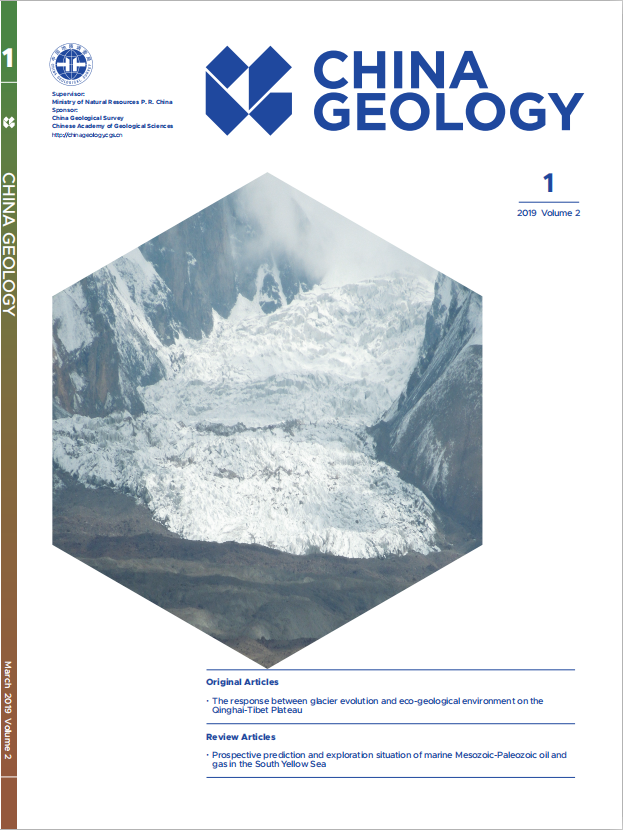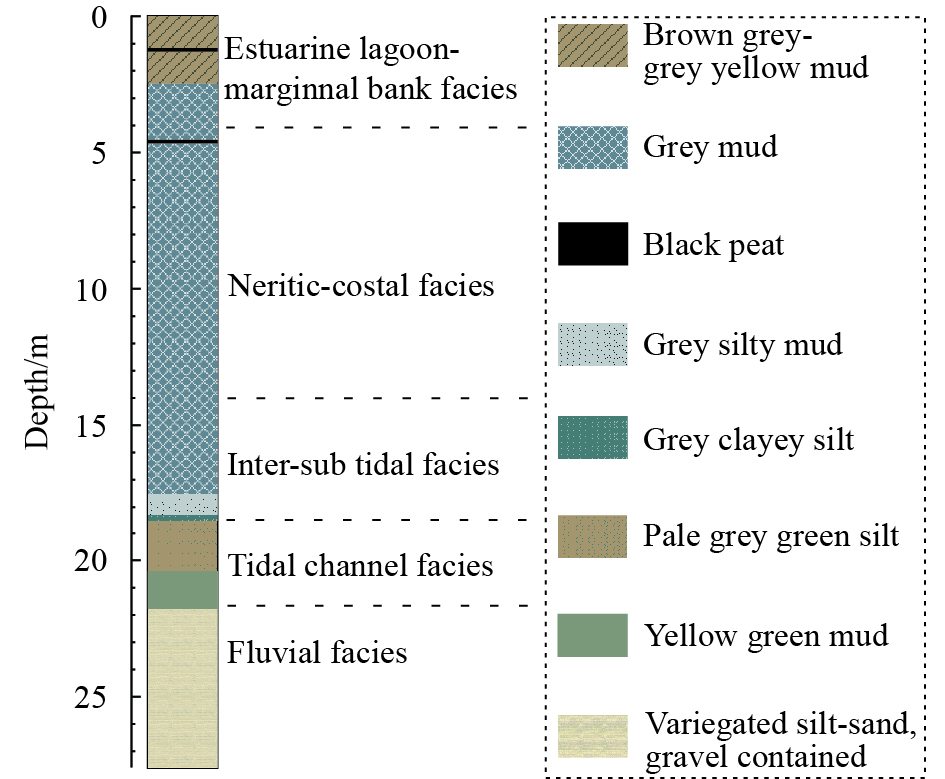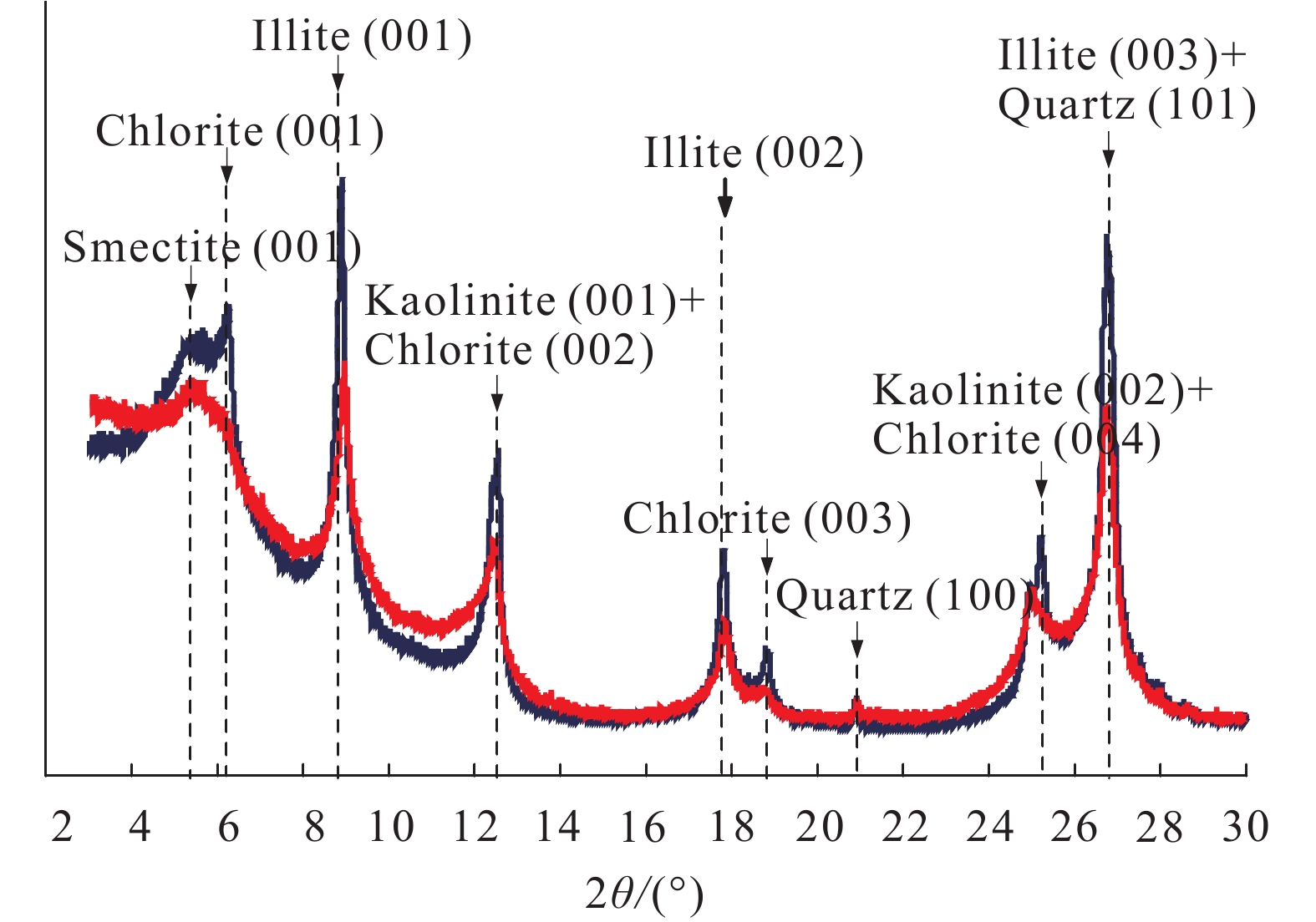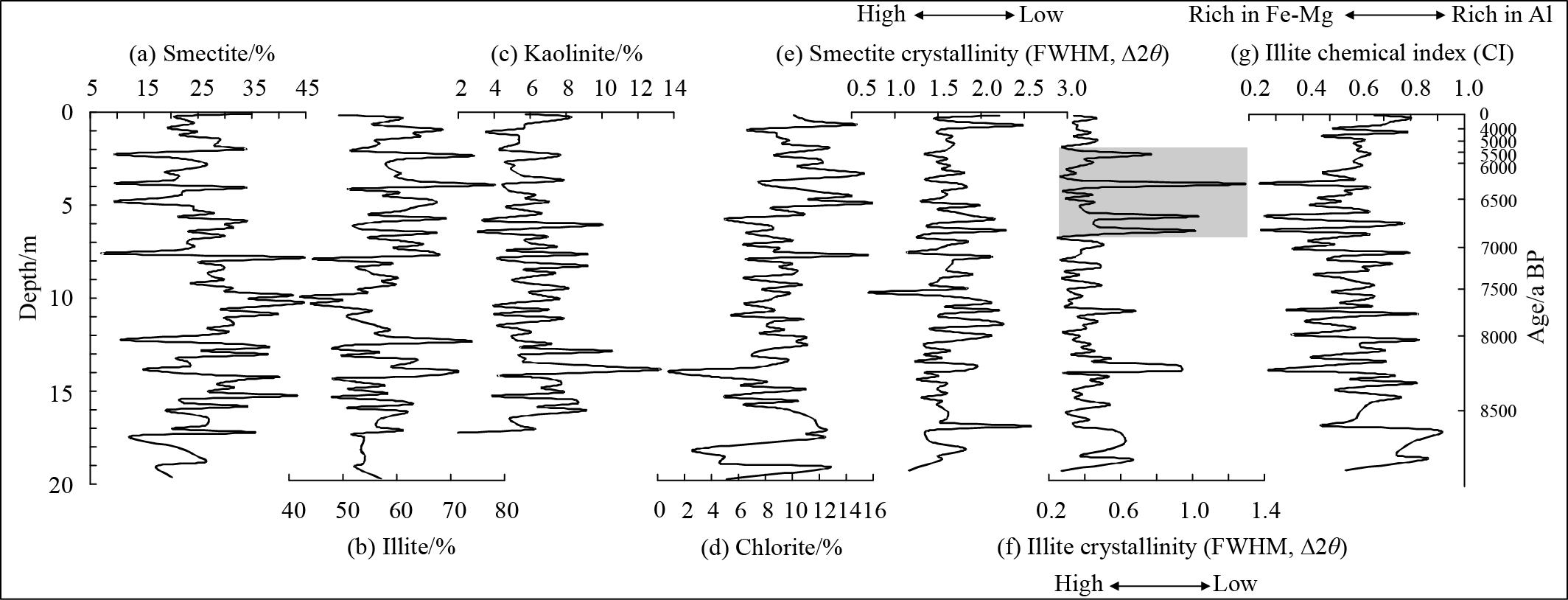| Citation: | Rui Liu, Xi Mei, Jin Zhang, De-bo Zhao, 2019. Characteristics of clay minerals in sediments of Hemudu area, Zhejiang, China in Holocene and their environmental significance, China Geology, 2, 8-15. doi: 10.31035/cg2018069 |
Characteristics of clay minerals in sediments of Hemudu area, Zhejiang, China in Holocene and their environmental significance
-
Abstract
The Ningshao Plain experienced sea-level fluctuation and climate change in the Holocene and gave birth to a Neolithic Civilization, the Hemudu Culture (about 5000 BC). Using XRD method, this paper studied the clay mineralogy of sediments in core HMD-1301 from Hemudu Site area in Ningshao Plain. Results show that the clay mineral assemblages in all samples are quite consistent. They are dominated by illite (about 57%) and smectite (about 26%), and a small amount of kaolinite (about 6%) and chlorite (about 9%). In addition, illite, chlorite, and kaolinite are originated mainly from eolian loesses. Smectite is resulted mainly from chemical weathering of local volcanic rocks outcropped. Illite crystallinity indicates the climatic characteristics of the source region, and illite chemistry index reflects the climate nature of the sedimentary area. It is our understanding that water medium properties in a sedimentary environment affect clay mineral assemblage and the distribution, based on which were cognized the Holocene transgression-regression events in the Hemudu Site area. These mineral indices are well comparable with geochemical indicators in identifying the transgression-regression events. We believe that these events affected the ancient civilization of the ancient residential communities at the time.
-
Keywords:
- clay minerals /
- provenance /
- Holocene /
- Hemudu Culture /
- Zhejiang
-

-
References
[1] An CB, Feng ZD, Tang LY. 2003. Evidence of a humid mid-Holocene in the western part of Chinese Loess Plateau. Chinese Science Bulletin, 48(22), 2472–2479. [2] Cao K, Li XH, Wang CS. 2008. The cretaceous clay minerals and paleoclimate in Sichuan Basin. Acta Geologica Sinica, 82(1), 115–123. [3] Chamley H. 1989. Clay Sedimentology. Berlin: Springer, 623. [4] Chen T, Wang H, Zhang ZQ, Wang HJ. 2003. Clay minerals as indicators of paleoclimate. Acta Petrologica et Mineralogica, 22(4), 416–420. [5] Clauer N. 1995. Clay minerals as records of temperature conditions and duration of thermal anomalies in the Paris Basin, France. Clay Minerals, 30, 1–30. doi: 10.1180/claymin.1995.030.1.01 [6] Diekmann B, Wopfner H. 1996. Petrographic and diagenetic signatures of climatic change in peri- and postglacial Karoo Sediments of SW Tanzania. Palaeogeography, Palaeoclimatology, Palaeoecology, 125, 5–25. doi: 10.1016/0031-0182(95)00084-4 [7] Dong HM, Song YG. 2009. Clay mineralogy and its application to paleoenvironmental reconstruction. Marine Geology and Quaternary Geology, 29(6), 119–130. [8] Edzwald JK, OpMelia CR. 1975. Clay distribution in recent estuarine sediment. Clays and Clay Minerals, 23, 39–44. doi: 10.1346/CCMN [9] Ehrmann W. 1998. Implications of late Eocene to early Miocene clay mineral assemblages in McMurdo Sound (Ross Sea, Antarctica) on paleo climate and ice dynamics. Palaeogeography, Palaeoclimatology, Palaeoecology, 139, 213–231. doi: 10.1016/S0031-0182(97)00138-7 [10] Gao S. 2013. Holocene sedimentary systems over the Bohai,Yellow and East China Sea region: recent progress in the study of process-product relationships. Acta Sedimentology Sinica, 31(5), 845–855. [11] Gingele FX, Müller PM, Schneider RR. 1998. Orbital forcing of freshwa-ter input in the Zaire Fan area clay mineral evidence from the last 200 kyr. Palaeogeography, Palaeoclimatology, Palaeoecology, 138, 17–26. doi: 10.1016/S0031-0182(97)00121-1 [12] Huang ZG, Zhang WQ, Xu SY. 2002. Comparison research on Holocene environment evolution of China and Japan. Guangzhou: Guangdong Science and Technology Press. [13] Huang J. 2011. Mineralogical and sedimentologic records in sediments of northern South China Sea Slope and their implications for tectonics and paleoenvironments. Qingdao: Institute of Oceanology, Chinese Academy of Sciences, 36–37. [14] Ji JF, Chen J, Lu HY. 1999. Origin of Illite in the loess from the Luochuan area Loess Plateau Central China. Clays and Clay Minerals, 34(4), 525–532. doi: 10.1180/000985599546398 [15] Lamy F, Klump J, Hebbeln D, Wefer G. 2000. Late Quaternary rapid climate change in northern Chile. Terra Nova, 12(1), 8–13. doi: 10.1046/j.1365-3121.2000.00265.x [16] Lang HR. 1987. Neolithic sites and Holocene sea level changes at Hemudu, Yuyao of Zhejiang. Zhejiang Geology, 3(1), 5–13. [17] Latouche C. 1978. Clay minerals as indicators of the Cenozoic evolution of the North Altlantic Ocean//Clay Conference Developments in Sedimentology, Amsterdam:Elsevier, 217-279. [18] Li CS, Shi XF, Gao SJ, Chen MD, Liu YG, Fang XS, Lv HH, Zou JJ, Liu SF, Qiao SQ. 2012. Clay mineral composition and their sources for the fluvial sediments of Taiwanese rivers. China Science Bulletin, 57, 673–681. doi: 10.1007/s11434-011-4824-1 [19] Li ML, Mo DW, Sun GP, Zhou KS, Mao LJ. 2009. Paleosalinity in Tianluoshan site and the relation between Hemudu Culture and its environmental background. Acta Geographica Sinica, 64(7), 807–816. [20] Liu L, Li XH, Wang Y, Zhou Y, Cao K. 2012. The early-mid Cretaceous changes of clay mineral composition from Zhejiang and Fujian Provinces, SE China: indications to paleoclimate changes. Acta Sedimentologica Sinica, 30(1), 120–127. [21] Liu ZF, Trentesaux A, Clemens SC, Colin C, Wang P, Huang B, Boulay S. 2003. Mineralogical and sedimentologic records of ODP 1146 in north slope of the South China Sea ocean currents carrying and East Asia monsoon evolution. Journal of Science in China, Series D, 33(3), 271–280. [22] Liu ZF, Tuo ST, Colin C, Liu JT, Huang CY, Selvaraj K, Chen CTA, Zhao Y, Siringan FP, Boulay S, Chen Z. 2008. Detrital fine-grained sediment contribution from Taiwan to the northern South China Sea and its relation to regional ocean circulation. Marine Geology, 255, 149–155. doi: 10.1016/j.margeo.2008.08.003 [23] Liu R, Qin JG, Mei X. 2014. Sedimentary environment changes of the Ningshao Plain since the later stage of the Late Pleistocene: Evidence from palynology and stable organic carbon isotopes. Quaternary International, 333, 188–197. doi: 10.1016/j.quaint.2013.10.055 [24] Liu R, Zheng HB. 2017. Variability of organic carbon isotope and C/N in the Hemudu area, Hangzhou bay and its environmental implications in the Holocene. Geochemistry International, 55(12), 1154–1163. doi: 10.1134/S001670291714004X [25] Lu CX. 1997. Clay minerals as indicators of paleoenvironment. Journal of Desert Research, 17(4), 456–460. [26] Luo D. 2011. Quaternary characteristics and lithofacies paleogeography of Ningbo area in Zhejiang. Chengdu: Chengdu University of Technology. [27] Meunier A. 1980. Les m canismes de loalt ration des granites et le role desmicrosystemes. Etude des arenas du massif granitique de Parthenay (Deux-Sevres). Memoires de la Societe Geologique de France, 59(140), 79. [28] Ming J, Li AC, Meng QY, Wang SM, Yan WW. 2012. Quaternary assemblage characteristic and provenance of clay minerals in the parecevela basin of the east Philippine sea. Marine Geology and Quaternary Geology, 32(4), 139–148. [29] Pandarinath K, Prasad S, Gupta SK. 1999. A 75 ka record of palaeoclimatic changes inferred from crystallinity of illite from NalSarovar, western India. Journal of Geology Society of India, 54(5), 515–522. [30] Parrish JT. 1998. Interpreting Pre-Quaternary climate from the geologic record. New York: Columbia University Press, 121-124. [31] Qin JG, Taylor D, Atahan P, Zhang XR, Wu GX, Dodson J, Zheng HB, Davey FI. 2011. Neolithic agriculture,freshwater resources and rapid environmental changes on the lower Yangtze, China. Quaternary Research, 75, 55–65. doi: 10.1016/j.yqres.2010.07.014 [32] QIN JG. 2006. Pollen records and the paleoenvironment in Ningshao Plain and its vicinage since late Pleistocene. Shanghai: Tongji University. [33] Quigley R M, Martin R T. 1963. Chloritized weathering products of a New England glacial till. Clay Mineral, 10, 107–116. [34] Ren LF. 1992. Clay mineral and claystone. Beijing: Geological Publishing House. [35] Singer A. 1984. The paleoclimatic in terpretion of clay minerals in sediments- a review. Earth Science Reviews, 21, 251–293. doi: 10.1016/0012-8252(84)90055-2 [36] Shan LL, Zhang JB, Xu HG, Lu BS. 2010. Study on feature and development of planation surface and basalt mesa landscape in Siming Mountain. Journal of Shanxi Agricultural Sciences, 38(8), 41–44. [37] Shi W, Ma CM, Jiao F, Zhu C, Wang FB. 2008. Archaeological sites, buried peat and fluctuation of sea-level in Holocene in the Ningshao Plain in Zhejiang Province, China. Acta Oceanologica Sinica, 30(4), 69–75. [38] Shi XF, Chen LR, Li KY, Wang ZL. 1995. Study on minerageny of the clay sediment in the west of Philippine Sea. Marine Geology and Quaternary Geology, 15(2), 61–71. [39] Shi YX, Dai XR, Song ZG, Zhang WG, Wang LQ. 2005. Characteristics of clay mineral assemblages and their spatial distribution of Chinese Loess in different climatic zones. Acta Sedimentology Sinica, 23(4), 690–695. [40] Sun XJ, Du NQ, Chen MH. 1981. The paleovegetation and paleoclimate during time of Hemudu people. Journal of Integrative Plant Biology, 23(2), 146–151. [41] Tang YJ, Jia JY, Xie XD. 2002. Environment significance of clay minerals. Earth Science Frontiers, 9(2), 337–344. [42] Vanderaveroet P. 2000. Miocene to Pleistocene clay mineral sedimentation on the New Jersey shelf. Oceanologica Acta, 23(1), 25–36. doi: 10.1016/S0399-1784(00)00102-X [43] Wang JH, Zheng Z. 1990. Approach of clay mineral and paleo-environment in the Quaternary of Hanjiang Delta. Acta Scientiarum Naturalium Universitatis Sunyatseni, 29(2), 133–136. [44] Wang ZH, Saito Y, Zhan Q, Nian XM, Pan DD, Wang L, Chen T, Xie JL, Li X, Jiang XZ. 2018a. Three-dimensional evolution of the Yangtze River mouth, China during the Holocene: impacts of sea level, climate and human activity. Earth-Science Reviews, 185, 938–955. doi: 10.1016/j.earscirev.2018.08.012 [45] Wang ZH, Ryves DB, Lei S, Nian XM, Lv Y, Tang L, Wang L, Wang JH, Chen J. 2018b. Middle Holocene marine flooding and human response in the south Yangtze coastal plain, East China. Quaternary Science Reviews, 187, 80–93. doi: 10.1016/j.quascirev.2018.03.001 [46] Xiao JY, Guo P, Wang D, Zhang RH, Ding JL. 2004. Palaeovegetation and palaeoenvironment and palaeoculture at Chudun Site in Taihu Plain during mid and late Holocene: a case study of Chudun Site in Suzhou. Journal of Nanjing Normal University (Natural Science), 27(2), 91–97. [47] Xu YH, Chen J, Wang AJ, Li YH,Wang WG, Zhang XF, Lai ZK. 2013. Clay minerals in surface sediments of the Taiwan Strait and their provenance. Acta Sedimentology Sinica, 31(1), 120–129. [48] Zhang Q, Jiang T, Shi YF. 2004. Paleoenvironmental changes in the Yangtze Delta during past 8000 years. Journal of Geographical Sciences, 14(1), 105–112. [49] Zhang SF. 1991. The peat in Ningshao Plain of Zhejiang Province and its reflection on the sea level changes. Journal of Nanjing Normal University (Natural Science), 14(1), 76–84. [50] Zhu C, Zheng CG, Ma CM, Yang XX, Gao XZ, Wang HM, Shao JH. 2003. On the Holocene sea level high stand along the Yangtze Delta and Ningshao Plain, East China. Chinese Science Bulletin, 48(23), 2428–2438. -
Access History

-
Figure 1.
Sketch map of the Ningshao Plain, location of the HMD-1301 core and geography of the Yaojiang River valley and its adjacent area.
-
Figure 2.
Lithostratigraphical profile of the HMD-1301 core.
-
Figure 3.
A typical XRD diagram of clay minerals of the HMD-1301 core, blue line is for the sample from depth of 5.40 m, red line is for 18.80 m.
-
Figure 4.
Variation of clay minerals assemblages and crystallinity index in the sediments of the HMD-1301 core since Holocene (the age data from reference of Liu R and Zheng HB, 2017).
-
Figure 5.
Correlation among the four types of clay minerals.





 DownLoad:
DownLoad:



